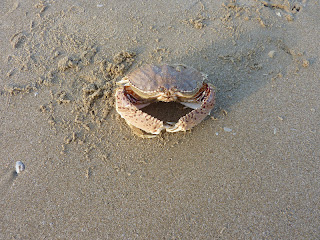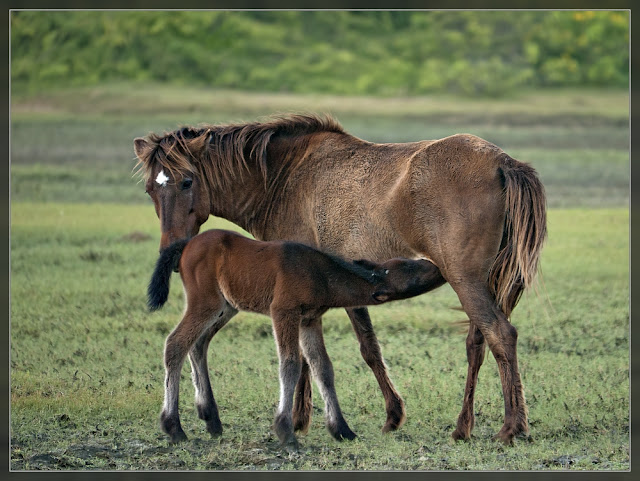 |
| The sand at the saltpans |
 |
| On the beach sands, near the Chola lighthouse |
So, we all indulged in virtual beachcombing, photographing all the pretty, colourful, unusual, large shells that we saw. I have tried to match my notes/names with the pictures I took - I hope I am correct, please do point out if I have wrongly identified. (Errors, if any are mine and not Uttara's!)
 |
| The waters near the boat jetty |
At the waterfront
...Then we
headed further south to the boat jetty where we saw crabs and star fish left
behind from the day’s catch. Later we headed further away from the fishing
boats to a quieter spot where we just roamed about, picking shells of all kinds
and pestering Preston uncle with questions about each one which he patiently
answered.
Uttara's account, which started here, now continues:
 |
| A dead starfish. Wonder what they do with them? |
 |
| The puffer fish Highly poisonous |
 |
| A capiz/windowpane oyster buried in the sand. Placuna placenta. Some translucent varieties used to make windowpanes! (Its a bivalve.) |
 |
| From L to R - Sundial, Murex, angelwing, spotted tun |
 |
| Bottom - screw shell. Above - I dont know, but it was pretty. |
 |
| More dead barnacles on a branch by the sea-shore. To see how these creatures, who cannot move on their own, feed, please click here. |
 |
| Is this a razor clam shell? |
 |
| The hermit |
Someone
found a hermit crab. It was a juvenile, a tiny red little thing in an
over-sized, borrowed shell. When we held it up, it scrambled all over the palms
of our hands and it took a lot to stop it from falling of. Finally we released
it back into the water and watched it being thrown back and forth by the waves
until it disappeared from sight.
At the saltpans
 |
| The notice that hung on the wall at our guest house on marine life that is protected. |
(Uttara)
We walked among the very large and small pools of saltwater that had been brought in from the sea which came in from both the south and the east. The large pools of water were separated by man-made mounds of dry soil. While there were a lot of Prosopis juliflora growing around the mudflats (some black-winged stilts were spotted here), marking the boundary, few plants grow in the area itself save for the few small bushes that grew around the mounds. On one side of the mudflats there grew the pooarasam or Portia tree also called Indian tulip tree (Thespesia populnea) which can grow in difficult conditions like near salt water and the sea coast. The land was dry and bare and in places cracked. Though proximity to water resulted in wetter soil, the land still retained its parched appearance.
 |
| Colourful spiral horn shells - all over the bunds surrounding the salt pans. |
But looks can be deceiving. While in most places, especially the mounds, it was perfectly safe to walk around, some areas were very marshy and when the earth gives way under one’s feet, it is certainly not a most pleasant sensation for most. I say this from first-hand experience.
 |
| Is this a banded tun shell? "Tun" supposedly means cask or wine jar. Tuns are typical of tropical water and feed on other small creatures. |
 |
| TL - Paper fig. Very light TR - Moon sea shell? Middle - Brown banded tun Bottom - screw shell |
 |
| Conus shell. The creature inside this is venomous and its sting is unpleasant, and shoots out on a proboscis at the narrow tip of the cone. |
 |
| L - I dont know/Forgot R - vase shell. Common on the eastern Indian coasts, despite their small size, they are predatory! |
 |
| A scallop bivalve, next to a very small spiral horn. Very common on our beaches |
When we returned, the light had faded from the sky. We gathered in the entrance lobby to begin talking about what had been done that day and what there was left and even some random stuff. Vikas, Vishwanath, Kedar and I mostly yelled at and fought with each other. Then began the daily list-making ritual with the usual “Order, order!” and “Disorder, disorder!”
By the boat jetty, on the last morning
(Me)
 |
| A crab eyeballs us, looking quite angry! |
The fishing village was a hive of activity. Motorbikes and cars whizzed past us, and we wondered what the excitement was all about. We arrived to see the auction in full swing - last evening's catch was being sold. Fisherfolks on cell phones, deals being struck, profits made. It reminded me of an article I read in The Economist long ago, of the positive effect of the cell phone on the fisherfolk of Kerala. Maybe this was the reason for traders coming in by car, having heard of a good catch that morning? We didn't find out.
 |
| R - A lovely Murex turnispina, quite common for our waters |
During our four day Pongal stay, we found that the price of fish and prawn rose significantly, almost from meal to meal. There was some joking as to how local demand was raising the prices, but it turns out, that the number of fishermen willing to go out to sea through the festival drops off, and this results in supply dropping substantially.
 |
| Sting rays, at the bottom of a freezer box. According to the poster in the guest house, this is a protected species. |
  |
| Turbanidae? |
We got talking to some young men who had just returned from the sea. Kodiakarai is approximately 50-60 kms from the tip of Sri Lanka, and we are always reading in the papers about fishermen from either country being arrested by the opposite coast guards, for straying into their waters.
 |
| An octopus was in their catch. Among the most intelligent of invertebrates |
As we wondered why they had to take these risks, one of the older fishermen remarked as to how the size of their catch is falling - there is just not enough fish, and how they need to go further and further. Sounded familiar - Downeaster Alexa from Billy Joel.
I know there is a 47 day ban on fishing or a fishing holiday around Chennai/TN coast, but that seems to be not enough? Sustainable fishing is the mantra of the government, but is it working on the ground? I dont know.
I also found it sad to see "unwanted" fish just being brought in, in the nets, dead and of no use.
More beautiful univalves.
 |
| A lovely, abandoned sea fan |
On our way back, we saw a cheerful and noisy bunch of rosy starlings in the undergrowth, and its amazing how their chatter can lift one's spirits.
As we got onto the southern most end of high street, we saw various other fellow MNS members sprinting, and so followed suit. and this is what we saw!
 |
| No marine creature this - a retreating wild boar. |
 |
| Some strange thing we came across. (Not the pen!) That was Hemal's touch of scientific observation. |

Lets hope that we learn and understand about sustainable living, sooner rather than later.
 |
| Signing off with this absolutely fantabulous specimen of a Murex (?). Photo by Mr Ramanan |



















































